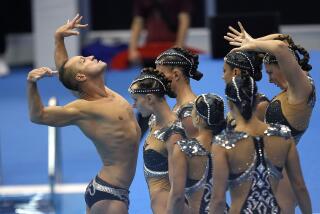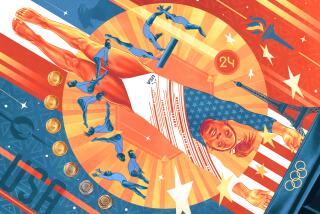The Ongoing Battle : Nancy Janik Counters Age, Diabetes by Improving Springboard Mechanics and Now Dives Better Than Ever
On the diving board, Nancy Janik is ageless. Her petite figure and lithesome grace belie her 32 years. Above the water, she throws the same twists and somersaults of competitors a dozen years younger. But her age is only half her battle.
Janik has been a diabetic since 14. Her blood-sugar level shoots up and down during meets and practices, causing her body to shake and her head to spin. When her blood-sugar level is too low, she drinks juice. When it soars too high, she injects herself with insulin, supplementing the three shots she takes each morning.
Often, the Simi Valley resident does not catch her condition until it is too late. During last month’s U.S. Olympic Festival for example, Janik had several soft drinks between dives to raise her blood-sugar level. But it is a gradual process and her blood-sugar level did not return to normal until her last dive.
“Workouts are very difficult,” said Van Austin, her coach. “She has difficulty feeling things kinesthetically and standing on the board. She only gets through half the workouts. Its been a real struggle for her.”
Janik also competes at a national level despite inadequate training. Her position as a computer software designer for Rocketdyne in Canoga Park limits her workouts to three or four per week with Austin and Tom Scotty at Rose Bowl Aquatics.
Yet Janik, who got back on the boards in December, 1990 after a three-year retirement, is a better diver than ever. At the Phillips 66 national championships on Thursday at USC, she finished fourth on the one-meter springboard. Today, she competes in the three-meter finals.
Surprisingly, her dives have improved, particularly her back 2 1/2-somersault on the three-meter.
“I think my mechanics are a little bit better,” said Janik, who dropped a few poor habits when she relearned all of her dives.
On her reverse 2 1/2-somersault, for instance, she spins faster because her head and arms are in the proper positions.
Austin believes Janik gets by on fewer workouts because of an intense competitive nature.
“She’s always been an incredible competitor,” he said. “Coming from a family of nine kids, that would do it.”
Although the majority of divers do not watch the standings between dives because they are concerned only about their own scores, Janik always wants to know where she stacks up.
“She’ll ask where she is and what she needs (number of points) on the next dive and she’ll go get it,” Austin said.
Janik’s leaping and spinning ability also is exceptional.
“Depending on the time of week and the physiological conditions with her diabetes, she’s incredible on all the dives on her list,” Austin said.
Janik’s successful summer--she placed fourth on the one meter and three meter in the Olympic Festival--stems from the thousands of dives she executed in practices last year. In preparation for the 1992 U.S. Olympic trials, Rocketdyne paid her a full-time salary for part-time work, enabling her to increase her time on the boards.
“It was unusual, especially with the bad economy,” Janik said. “Without the support of companies like mine, we have no chance because the athletes from other countries are training six to eight hours a day.”
Janik did not advance to the 12-woman finals at the trials, yet less than a year later she ranks consistently in the top four nationally and will be eligible for training stipends from U.S. Diving, the national governing body of the sport.
Such funding would enable her to train full time while working part time.
“I’d love to have that opportunity again,” Janik said, “especially with World Championships coming up next year.”
In the meantime, she endures a nonstop schedule on days that she works and trains. Typically, she arises at 5:30 a.m. and works from 7 a.m. to 2 p.m., helping design the software for the electrical power system on the space station. Then, she drives to the Rose Bowl Aquatic Center in Pasadena for practice from 3-5:30 p.m. She is home by 7 and often works into the night on the diving software program she has designed with her husband, Donald.
The pressure of being in each place on time and performing at a high level, not to mention the interim periods stuck in freeway traffic, is often too much.
“I have a lot of those days,” Janik said. “Sometimes in the middle of the workout, I’m too tired. Sometimes I can’t get through it and I stop and go home.”
Austin is understanding and supportive. He began coaching Nancy and her oldest sister Laurie in 1971. By 1975, 15-year-old Nancy won the first of six age-group national titles. As a junior at Royal High, she earned a berth on the U.S. national team, placing third on the one meter and sixth on the three meter in the national championships and qualifying for a meet against the Russians and East Germans.
In college, she faced a different type of competitor. Since Pepperdine didn’t field a women’s team, she dived against men.
“I don’t know if they were too happy about it, but for me it was fun,” said Janik, who won the conference title her sophomore year.
At 27, in the wake of an unsuccessful attempt to make the 1988 U.S. Olympic team, Janik retired. Initially, she did not miss diving because she was busy planning her wedding, participating in church functions and fulfilling the demands of her career.
Out of curiosity and a desire to visit Austin, Janik stopped by the Rose Bowl in December, 1990. She could not resist the sparkling new swimming pools and found herself back on the boards a dozen times.
Eventually, she entered local meets simply to get back into shape.
What she didn’t count on was regaining her form and the ability to throw even the most difficult dives.
“I hadn’t lost that much,” Janik said.
Her return to the water also inspired a collaboration of her knowledge of the sport and her software-design talents. With the help of her husband, who also is a software engineer at Rocketdyne, Janik designed a software system for the scoring of diving meets.
It not only eliminates costly errors and reduces preparation time, it requires only three people to operate. Currently seven people, usually volunteers, are needed to run a local or regional diving meet.
The coding required for the system is massive and after almost a year of work, Nancy and Donald shelved it in 1992. Earlier this year, they found the energy and inspiration to complete it.
“You know what you want to do but you’re not sure how to solve the problems,” Janik said. “It’s a very creative endeavor.”
And its steep challenges are typical of those Janik embraces. Whether it is regulating her blood-sugar level or the fine line between her career and her diving, Janik always seems to make a clean entry.
More to Read
Go beyond the scoreboard
Get the latest on L.A.'s teams in the daily Sports Report newsletter.
You may occasionally receive promotional content from the Los Angeles Times.






